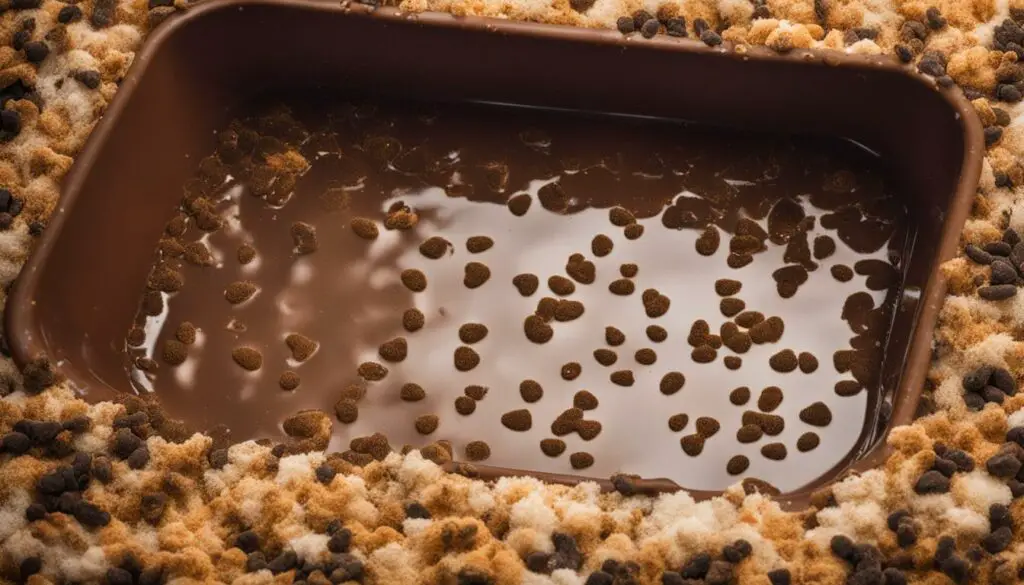Is your cat leaving poop stains around your home? Don’t worry, I’m here to help! In this article, we will explore the reasons why cats leave poop stains and provide solutions to prevent this behavior. It’s important to understand that this is not a normal behavior for cats and may be a sign of an underlying medical problem. Let’s dive in and find out why your cat is leaving poop stains and how we can put an end to it.
Key Takeaways:
- Cat leaving poop stains is not normal and may indicate an underlying issue
- Check for external factors like diet and litter box conditions
- Visit the vet to rule out any medical conditions
- Provide a clean and spacious litter box
- Address any hygiene or fur-trapping issues
Is It Normal For My Cat To Leave Poop Stains?
No, it is not normal for your cat to leave poop stains. If your cat is leaving poop stains where they sit, it is important to investigate the underlying cause. Check for external factors such as diet issues, inappropriate litter box conditions, or hygiene issues from long fur. If none of these external factors are causing the issue, a visit to the vet is recommended to rule out any internal illnesses.
Common Causes of Poop Stains
There are several reasons why cats may leave poop stains. One common reason is diarrhea or constipation. If a cat has diarrhea, they may not be able to make it to the litter box in time, resulting in poop stains around the house. On the other hand, constipation can cause the fecal matter to attach to the fur, leading to poop stains. Other factors such as long fur or issues with the litter box can also contribute to this behavior.
“No, it is not normal for your cat to leave poop stains.”
To prevent your cat from leaving poop stains in the house, it is important to identify and address the underlying cause. Start by checking external factors such as diet and litter box conditions. If the issue persists, consult with a vet to rule out any medical conditions. Providing a clean, spacious litter box and addressing any hygiene or fur-trapping issues can also help prevent poop stains.
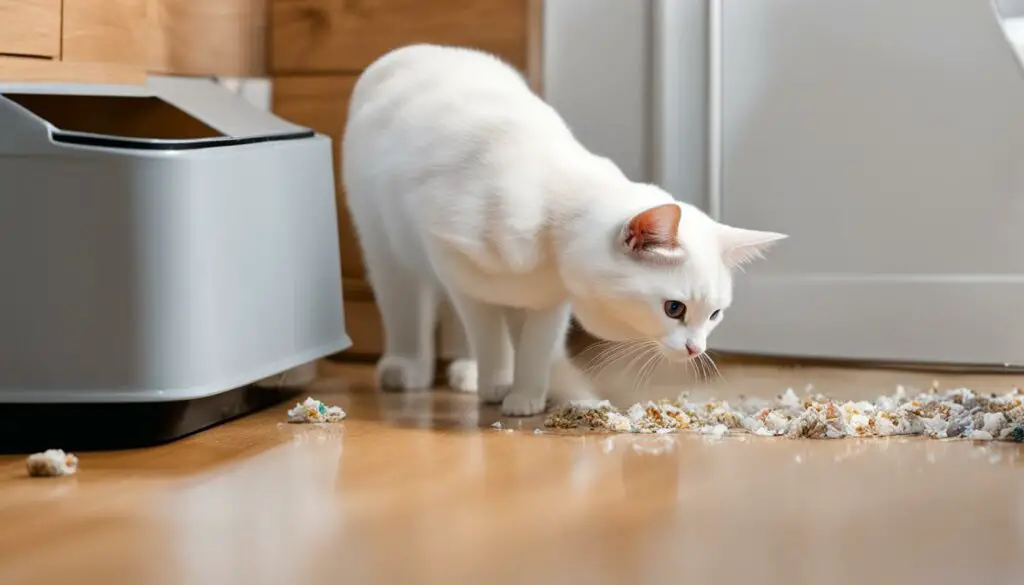
Why Do Cats Leave Poop Stains?
There are several reasons why cats may leave poop stains in your home. One common cause is diarrhea or constipation. Cats with diarrhea may not be able to reach the litter box in time, resulting in accidents and poop stains around the house. On the other hand, cats with constipation can have fecal matter that sticks to their fur, leading to poop stains when they sit or move around.
Another factor that can contribute to cats leaving poop stains is long fur. Cats with longer fur are more prone to hygiene issues, and feces can easily get trapped in their fur. This can lead to poop stains as the feces come into contact with surfaces in your home.
Issues with the litter box can also play a role in cats leaving poop stains. If the litter box is not cleaned regularly or is too small for the cat, they may avoid using it or have accidents outside of it. Older cats or cats with mobility issues may also struggle to use the litter box properly, increasing the chances of poop stains in your home.
Related:
While the reasons for cats leaving poop stains can vary, it is important to address the underlying cause and take steps to prevent this behavior. By providing a clean and spacious litter box, regularly grooming and trimming the fur of long-haired cats, and ensuring proper hygiene and health, you can minimize the chances of your cat leaving poop stains in your home.
Table: Common Causes of Cat Poop Stains
| Cause | Description |
|---|---|
| Diarrhea | Cats with diarrhea may have accidents outside the litter box, resulting in poop stains. |
| Constipation | Constipated cats may have fecal matter that sticks to their fur, leading to poop stains. |
| Long fur | Cats with long fur are more prone to hygiene issues and may have trapped feces in their fur, causing poop stains. |
| Litter box issues | Problems with the litter box, such as lack of cleanliness or improper size, can contribute to cats leaving poop stains. |
Understanding the reasons why cats leave poop stains can help you address the issue and maintain a clean and hygienic environment in your home. By providing the necessary care, attention, and proper litter box conditions, you can help prevent poop stains and ensure your cat’s well-being.
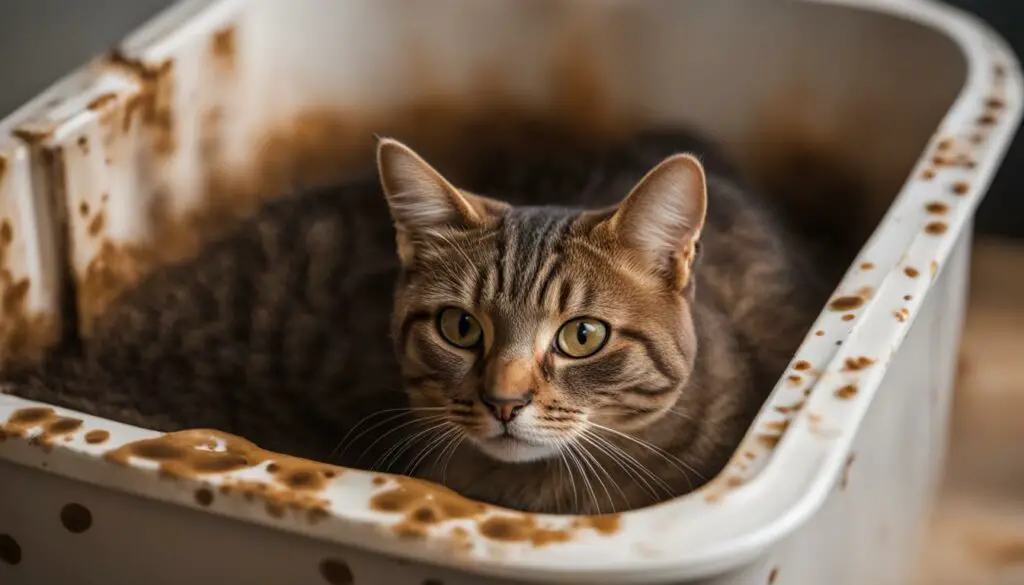
Your Cat Has Diarrhea Or Is Constipated
If your cat is leaving poop stains around the house, it could be a sign that they have diarrhea or are constipated. Diarrhea can cause accidents outside the litter box, resulting in poop stains. This can be caused by various factors such as dietary changes or underlying medical conditions. Constipation, on the other hand, can lead to fecal matter sticking to the fur during attempts to poop, which can also result in poop stains.
To address these issues, it is crucial to seek prompt veterinary attention. A veterinarian will be able to diagnose and treat the underlying cause of your cat’s diarrhea or constipation. They may recommend dietary adjustments, medication, or other treatments to help regulate your cat’s bowel movements and prevent poop stains.
In the meantime, you can take some steps to minimize the impact of diarrhea or constipation on your cat’s hygiene. Keep a close eye on your cat’s litter box habits and clean the litter box regularly to provide a clean and inviting environment. Additionally, consider trimming the fur around your cat’s bum to reduce the chances of poop sticking to the fur. These measures, coupled with veterinary care, can help alleviate your cat’s bathroom issues and prevent poop stains in your home.
| Steps to Address Diarrhea or Constipation in Cats |
|---|
| 1. Consult with a veterinarian to diagnose and treat the underlying cause of your cat’s diarrhea or constipation. |
| 2. Follow the veterinarian’s recommendations for dietary adjustments, medications, or other treatments. |
| 3. Monitor your cat’s litter box habits and clean the litter box regularly to provide a clean environment. |
| 4. Consider trimming the fur around your cat’s bum to prevent poop from sticking to the fur. |
You Have a Long-Haired Cat
If you have a long-haired cat, you may be more familiar with the challenge of dealing with hygiene issues, including poop stains. The longer fur of these cats increases the chances of feces getting trapped, leading to stains in your home. However, there are steps you can take to minimize this problem and keep your home clean and odor-free.
Trimming the Fur
One effective solution is to regularly trim the fur around your cat’s bum. This can help prevent feces from getting stuck and minimize the risk of stains. Make sure to use proper grooming tools and techniques to ensure the process is safe and comfortable for your cat.
Providing a Spacious Litter Box
Another way to address this issue is by providing a spacious litter box for your long-haired cat. A larger litter box gives your cat more room to maneuver and reduces the likelihood of them stepping in their own waste. Additionally, consider using a litter mat to catch any litter or waste that may cling to your cat’s fur.
By taking these steps, you can help prevent poop stains in your home and ensure a clean and hygienic environment for both you and your long-haired cat.
| Benefits | Tips |
|---|---|
| Prevents feces from getting trapped in fur | Regularly trim your cat’s fur around the bum |
| Reduces likelihood of poop stains | Provide a spacious litter box for your cat |
| Promotes cleanliness and hygiene | Use a litter mat to catch any litter or waste |
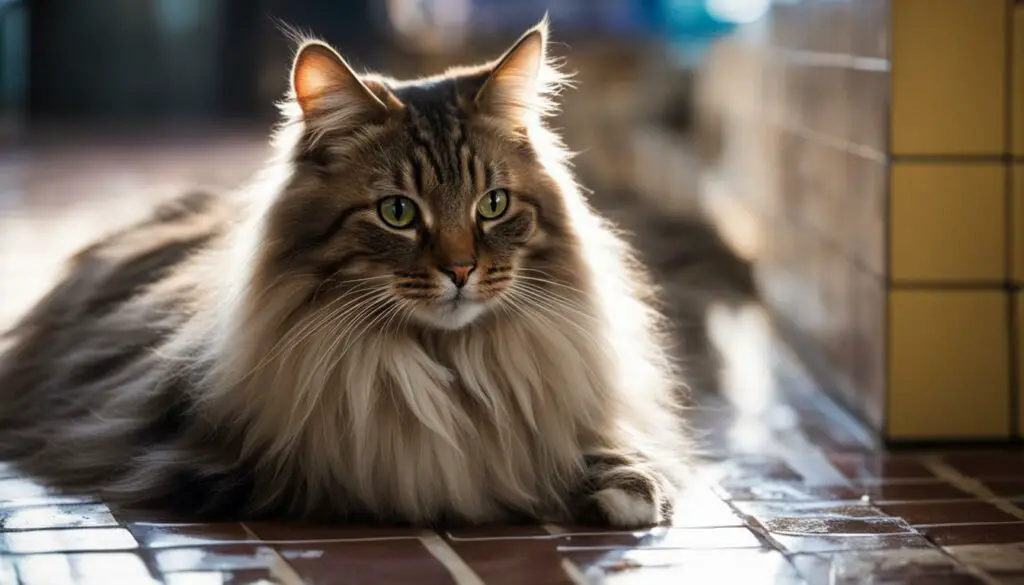
There Are Issues With Your Cat’s Litter Box
If your cat is leaving poop stains around the house, one possible reason could be issues with their litter box. Cats are very clean animals and are generally meticulous about their toileting habits. However, if the litter box is not suitable or meets their preferences, they may refuse to use it or have accidents outside of it.
One common problem is a litter box that is not cleaned regularly. Cats are sensitive to smells, and a dirty litter box can be off-putting for them. It’s important to scoop the litter box at least once a day and change the litter completely on a regular basis to ensure a clean and inviting environment for your cat.
The size of the litter box can also be a determining factor. If it’s too small for your cat, they may have difficulty maneuvering and feel uncomfortable while using it. Providing a spacious litter box with enough room for your cat to turn around and dig comfortably can encourage proper toileting behavior.
| Litter Box Issues | Possible Solutions |
|---|---|
| Unclean litter box | Regularly clean and maintain the litter box |
| Small litter box | Provide a larger, more spacious litter box |
| Inappropriate litter substrate | Experiment with different types of litter to find what your cat prefers |
| Location of the litter box | Place the litter box in a quiet and accessible area |
In some cases, cats may also have a preference for a specific type of litter substrate. Experimenting with different types of litter, such as clumping, non-clumping, or natural alternatives, can help you determine what your cat likes best.
Lastly, the location of the litter box is crucial. Cats prefer privacy and quiet when using the litter box, so placing it in a secluded area away from high traffic or noise can help create a comfortable environment for your cat to do their business.
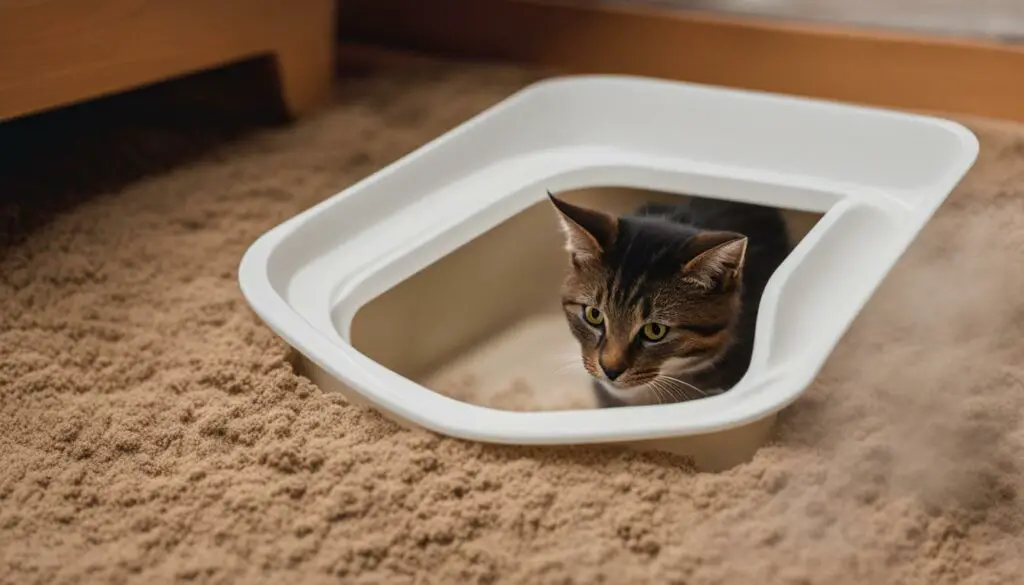
By addressing any issues with your cat’s litter box, you can help prevent poop stains in your home. Remember to keep the litter box clean, provide the right size and substrate, and choose a suitable location. Creating a pleasant and inviting toileting environment will encourage your cat to use the litter box consistently and reduce the chances of accidents and poop stains around the house.
How Can I Stop My Cat From Leaving Poop Stains Around The House?
If your cat is leaving poop stains around the house, it’s important to address the underlying causes to prevent this behavior. Here are some steps you can take:
- Check for medical issues: Schedule a visit to the vet to rule out any underlying health conditions that may be causing your cat to leave poop stains. Gastrointestinal disorders or urinary tract diseases can contribute to this behavior.
- Maintain a clean litter box: Ensure that the litter box is cleaned regularly to encourage your cat to use it. Cats are clean animals and may avoid a dirty litter box.
- Provide a suitable litter box environment: Make sure the litter box is spacious enough for your cat to move comfortably. If you have a long-haired cat, consider trimming the fur around their bum to prevent feces from getting stuck.
- Adjust your cat’s diet: If your cat is experiencing diarrhea or constipation, it may be helpful to review their diet with your vet. Dietary changes can sometimes alleviate these issues and prevent poop stains.
By addressing these factors, you can help prevent your cat from leaving poop stains in the house and promote a clean and hygienic environment.
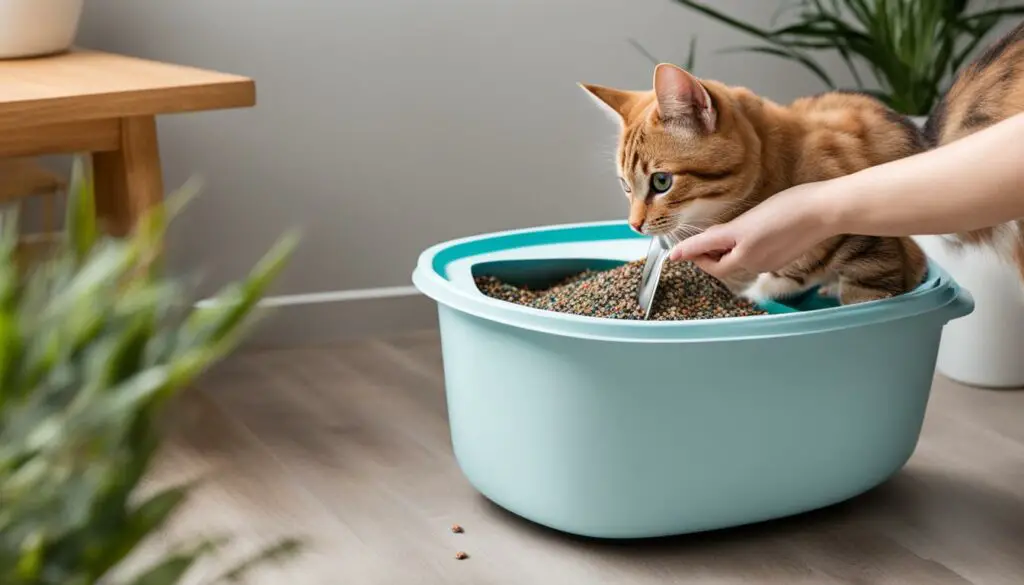
Table: Common Causes of Cat Poop Stains
| Cause | Explanation |
|---|---|
| Medical issues | Gastrointestinal disorders or urinary tract diseases can affect a cat’s bowel movements and result in poop stains. |
| Dirty litter box | If the litter box is not cleaned regularly, cats may avoid using it and have accidents around the house. |
| Inappropriate litter box conditions | A small or poorly maintained litter box may discourage cats from using it properly and lead to poop stains. |
| Dietary issues | An imbalanced diet or sudden changes in the cat’s food can cause diarrhea or constipation, contributing to poop stains. |
By addressing these common causes, you can minimize the chances of your cat leaving poop stains and ensure a clean and healthy environment for both you and your cat.
How Do I Remove Cat Poop Stains From Around My Home?
If your cat has left poop stains around your home, it is important to clean them promptly and effectively. Follow these steps to ensure proper removal:
- Begin by removing any solid lumps of poop with a paper towel. Carefully scoop up the poop and dispose of it in a sealed bag.
- For runny or watery stool, use a paper towel to wipe up as much as possible before treating the affected area. Blot the stain gently, taking care not to spread it further.
- Mix a solution of detergent and water. Apply this mixture to the soiled area, saturating it thoroughly. Allow the solution to sit for a few minutes to break down the stain.
- Once the stain has been treated, use a bristly brush or scrubbing brush to gently work the detergent into the stain. Scrub in small circular motions to lift the poop stain from the surface.
- After scrubbing, use a clean paper towel or cloth to wipe away the soapy suds. Rinse the area with clean water and blot dry with a fresh towel.
- Repeat the cleaning process if necessary, until the poop stain is completely removed.
- Finally, use a pet-safe spray or odor neutralizer to eliminate any lingering smells. This will help discourage your cat from revisiting the same spot in the future.
Remember, it’s essential to use pet-friendly cleaning products to ensure the safety and well-being of your cat. Avoid using harsh chemicals or bleach, as these can be harmful to your cat and may damage your home’s surfaces.
By following these steps, you can effectively remove cat poop stains from around your home, maintaining a clean and hygienic living environment for both you and your feline friend.
Note: In case the stain persists or if you have concerns about the cleaning process, consider consulting a professional cleaner or veterinarian for further assistance.

Cats and Feces in Communication
When it comes to cats leaving poop stains in the house, there is more to it than just a hygiene problem. Cats use their feces as a form of communication, utilizing their sense of smell to convey important information to other cats and even humans. This behavior is rooted in their natural instincts, but it can be problematic when it results in exposed poop stains around the house.
Through their feces, cats can communicate a variety of messages, including their sex, reproductive status, and even their health condition. The precise purpose of these messages is not fully understood, but it is clear that cats rely on this form of communication to establish their territory and assert their presence.
“Cats are creatures of habit, and their toileting behavior is no exception. Leaving exposed poop stains can be a way for cats to mark their territory and signal their presence to other animals.”
While some cats may choose to bury or cover their poop, others may deliberately leave it exposed as a form of territorial declaration. This behavior is more common in outdoor cats, but it can also occur in multi-cat households where cats may feel threatened or stressed. Understanding the underlying reasons behind this behavior can help address and modify it effectively.
Table: Reasons for Cats Leaving Poop Stains
| Reasons | Description |
|---|---|
| Communication | Cats use their feces to convey information about their sex, reproductive status, and health condition. |
| Territorial Declaration | Leaving exposed poop stains can be a way for cats to mark their territory and assert their presence. |
| Social Tensions | Multi-species households or situations where cats feel threatened can lead to cats not burying or covering their poop. |
While it may be challenging to completely eliminate this behavior, providing separate resources, minimizing stress, and creating safe spaces for cats can help alleviate tensions and promote better toileting behavior. Additionally, maintaining a clean litter box and promptly cleaning any poop stains can contribute to a hygienic living environment for both cats and their human companions.
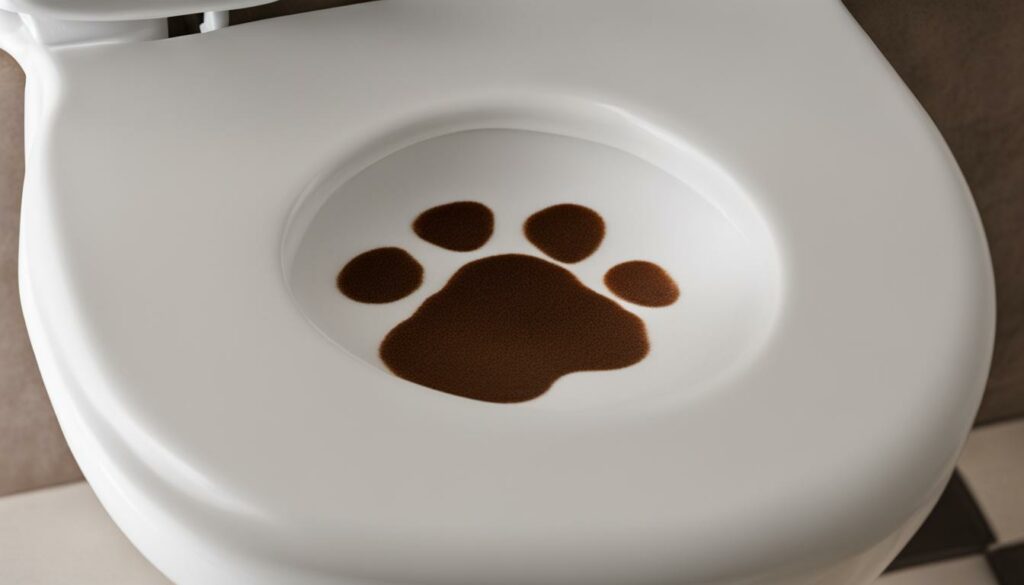
Why Doesn’t My Cat Bury or Cover Her Poop?
Cats not burying or covering their poop can be a puzzling behavior for many cat owners. There are several reasons why this might happen, and understanding them can help address and modify this behavior. Some possible explanations include:
- Medical Issues: Cats may not bury their poop if they are experiencing gastrointestinal disorders, urinary tract diseases, or pain while defecating. It is important to consult with a vet to rule out any underlying medical issues and provide appropriate treatment.
- Litter Box Dissatisfaction: Cats may choose not to bury their poop if they are dissatisfied with the litter box conditions. This can include factors such as the location, size, substrate, or cleanliness of the litter box. Ensuring that the litter box meets the cat’s preferences and is kept clean can help encourage proper toileting behavior.
- Territorial Declaration: Leaving exposed feces can be a way for cats to mark their territory and communicate their presence to other animals. This behavior is more common in outdoor cats but can also occur in multi-cat households.
- Early Experiences: Cats may learn not to bury their poop if they had negative experiences with litter boxes in the past. Traumatic events or uncomfortable encounters with other cats while using the litter box can create aversions and lead to this behavior.
Medical Issues
“Cats not burying their poop can be a sign of underlying medical issues.” Medical conditions such as gastrointestinal disorders, urinary tract diseases, and pain while defecating can affect a cat’s ability to bury or cover their poop. It is important to consult with a vet to rule out any underlying medical issues and provide appropriate treatment.
Litter Box Dissatisfaction
“Litter box conditions can play a role in a cat’s decision to not bury their poop.” Cats may choose not to bury their poop if they are dissatisfied with the litter box conditions. This can include factors such as the location, size, substrate, or cleanliness of the litter box. Ensuring that the litter box meets the cat’s preferences and is kept clean can help encourage proper toileting behavior.
Territorial Declaration
“Cats may leave exposed poop as a way to mark their territory.” Leaving exposed feces can be a way for cats to mark their territory and communicate their presence to other animals. This behavior is more common in outdoor cats but can also occur in multi-cat households.
Early Experiences
“Negative experiences with litter boxes can lead to cats not burying their poop.” Cats may learn not to bury their poop if they had negative experiences with litter boxes in the past. Traumatic events or uncomfortable encounters with other cats while using the litter box can create aversions and lead to this behavior.
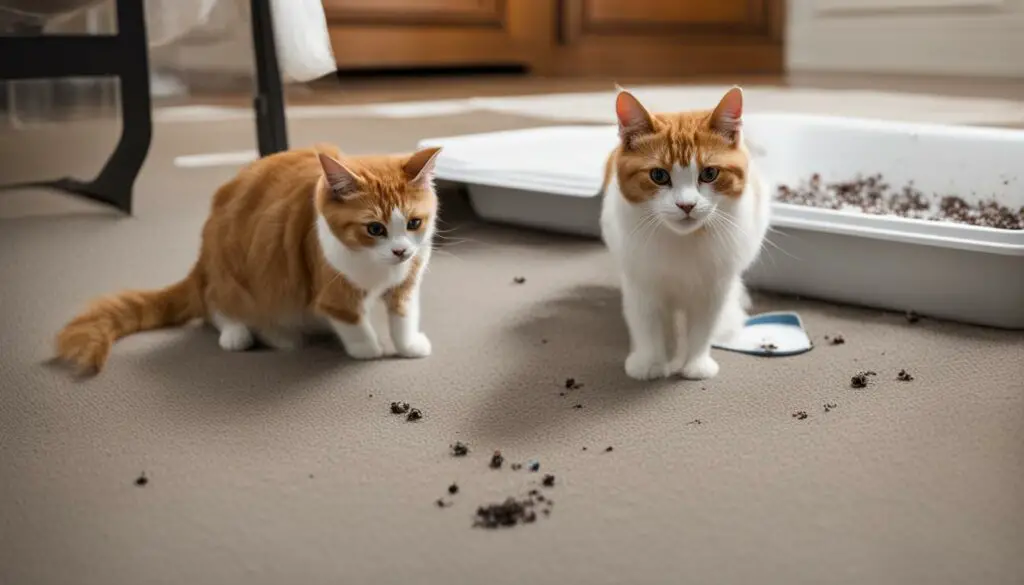
Understanding the reasons why cats don’t bury or cover their poop can help cat owners address and modify this behavior. By taking into account possible medical issues, ensuring litter box satisfaction, and considering past experiences, you can create an environment that promotes proper toileting behavior in your cat.
Possible Medical Issues
If your cat is leaving poop stains around the house, it could be a sign of underlying medical issues. Cats with gastrointestinal disorders, urinary tract diseases, or pain while defecating may struggle to bury or cover their poop properly. It is important to consult with a veterinarian to rule out any medical conditions and provide appropriate treatment. By addressing these underlying health issues, you can help prevent poop stains and promote better overall hygiene for your cat.
In some cases, cats may experience diarrhea or constipation, which can also contribute to poop stains. Diarrhea can cause accidents outside the litter box, while constipation can lead to feces sticking to the fur during attempts to defecate. Prompt veterinary attention is necessary to address these issues and provide the necessary treatment and relief for your cat.
To determine if your cat’s poop stains are due to medical issues, it is important to observe their behavior and look for any accompanying symptoms. If you notice any changes in their litter box habits, weight loss, lethargy, or loss of appetite, these could be signs of an underlying medical condition. Seeking prompt veterinary care can help identify and address the root cause of the problem.
Litter Box Dissatisfaction
If your cat is not burying or covering their poop, it could be due to dissatisfaction with the litter box conditions. Cats are highly sensitive to their environment, including their toileting area. Here are some factors to consider:
Litter Box Location
The location of the litter box can greatly influence your cat’s comfort and willingness to use it. Ensure that it is placed in a quiet and easily accessible area of the house. Cats prefer privacy when using the litter box, so avoid high-traffic areas or places where they may feel cornered or trapped.
Litter Box Size
The size of the litter box matters. It should be large enough for your cat to move around comfortably and easily turn around. If the litter box is too small, your cat may avoid using it or find it challenging to cover their poop adequately.
Litter Substrate
Cats have preferences when it comes to the type of litter substrate. Experiment with different textures such as clumping, non-clumping, or natural substrates like sand or wood pellets, to find the one that your cat prefers. Some cats may have aversions to scented or heavily perfumed litters, so opt for unscented options if your cat shows signs of dislike.
Litter Box Hygiene
Cats are clean animals, and they prefer a clean litter box. Regularly scoop out waste and clumps, and completely change the litter on a weekly basis. Keep in mind that some cats may be more sensitive than others, so they may require more frequent cleaning or a separate litter box for urine and feces.
By addressing these factors and ensuring that the litter box is suitable for your cat’s preferences, you can encourage proper toileting behavior and reduce the risk of poop stains in your home.
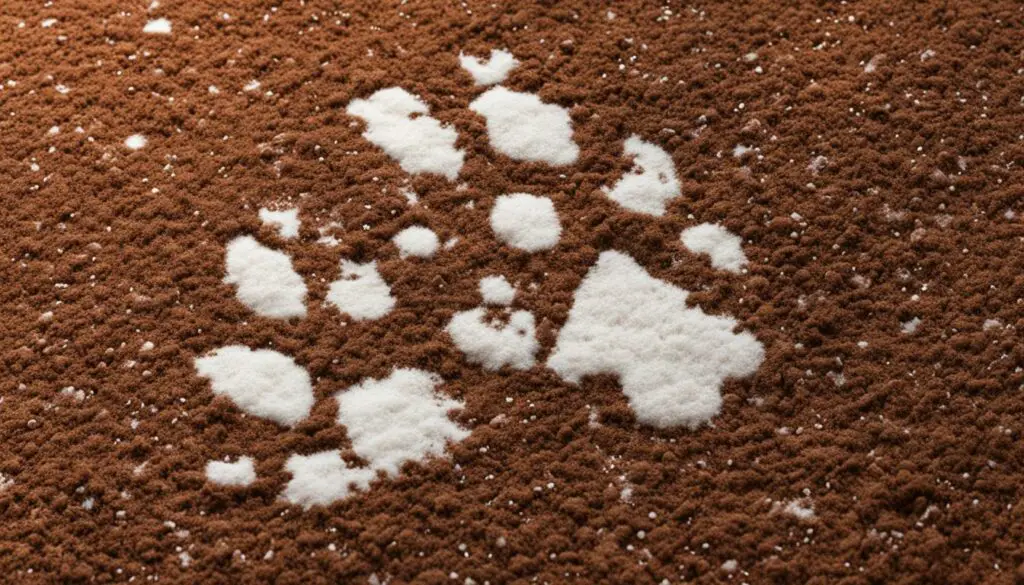
Table: Litter Box Dissatisfaction Factors and Solutions
| Factors | Possible Solutions |
|---|---|
| Litter Box Location | Place the litter box in a quiet and easily accessible area. |
| Litter Box Size | Ensure the litter box is large enough for your cat to move comfortably. |
| Litter Substrate | Experiment with different litter types to find the one your cat prefers. |
| Litter Box Hygiene | Regularly clean and maintain the litter box to keep it fresh and inviting. |
Territorial Declaration
When cats choose not to bury or cover their poop, it can be a form of territorial declaration. By leaving their feces exposed, cats are communicating their presence and establishing their territory. While this behavior is more commonly seen in outdoor cats, it can also occur in multi-cat households.
Cats have a strong instinct to mark their territory, and leaving poop stains is one way they can achieve this. The scent of their feces can serve as a clear indicator to other cats that they have claimed a particular area. This behavior is especially prevalent in unneutered cats, as they are more likely to engage in territorial marking.
It is important to note that while territorial declaration through poop staining is a natural behavior for cats, it can be problematic when it happens inside the house. Cleaning up the stains promptly and addressing any underlying issues can help prevent this behavior from becoming an ongoing problem.
| Reasons for Territorial Declaration | Impact on Cat Hygiene |
|---|---|
| Establishing territory and warding off potential threats | Can lead to unsightly poop stains around the house |
| Communicating reproductive status to other cats | Can create an unpleasant odor and unsanitary conditions |
| Sending a message of dominance to other cats | May contribute to hygiene issues and the spread of bacteria |
To prevent territorial declaration through poop staining, it is important to create a harmonious environment for your cat. Providing separate resources such as food bowls, litter boxes, and resting areas can help minimize competition and reduce the need for territorial marking. Additionally, ensuring a clean litter box and addressing any potential stressors in the cat’s environment can help promote proper toileting behavior.
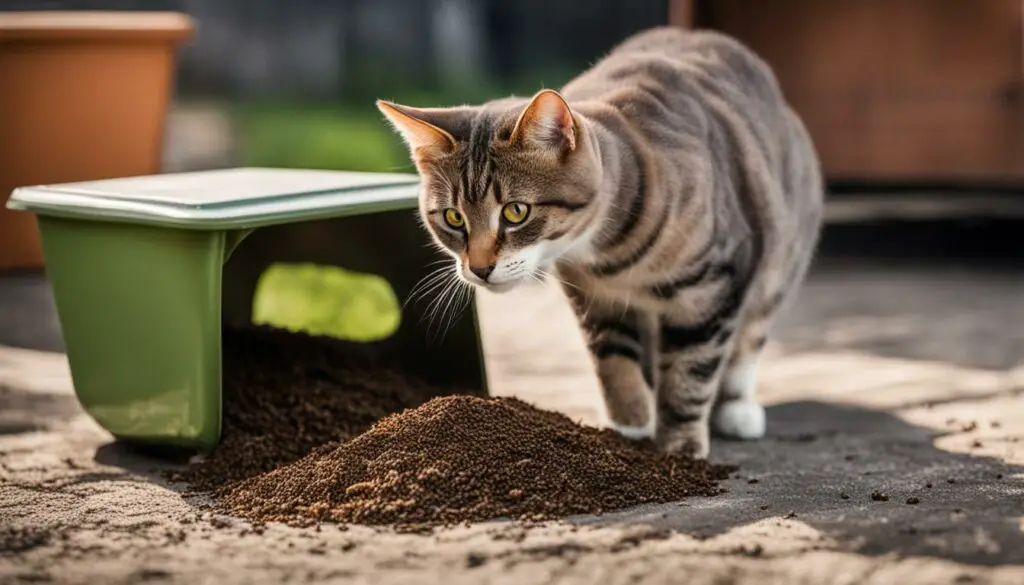
Quotes
“Cats have a strong instinct to mark their territory, and leaving poop stains is one way they can achieve this.”
“Cleaning up the stains promptly and addressing any underlying issues can help prevent this behavior from becoming an ongoing problem.”
By understanding the reasons behind territorial declaration through poop staining and taking appropriate measures to address the behavior, you can help maintain a clean and hygienic living environment for both your cat and yourself.
Household Social Tensions
In multi-species households or situations where cats feel threatened by dogs or other cats, social tensions can arise. These tensions can lead to cats exhibiting undesirable behaviors, such as not burying or covering their poop. When cats feel stressed or anxious, they may prioritize marking their territory over maintaining proper toileting habits. This can result in the presence of exposed poop stains in the house.
To alleviate social tensions and promote proper toileting behavior, it is important to provide separate resources for each pet. This includes individual litter boxes, feeding areas, and resting spaces. Creating safe spaces where cats can retreat and feel secure can also help reduce tension and minimize stress. Additionally, minimizing interactions that may trigger conflicts between pets can contribute to a more harmonious living environment.
It is crucial to address household social tensions promptly, as ongoing conflicts can exacerbate the issue of cats not burying or covering their poop. By creating an environment that supports positive relationships between pets and reduces stress, you can help encourage proper toileting behavior and maintain a clean and hygienic home.
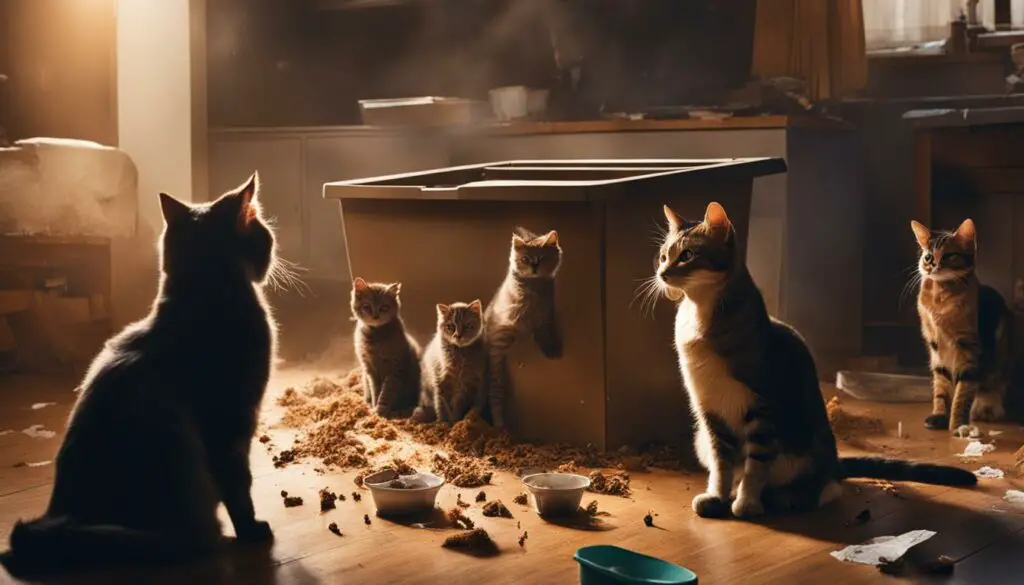
Senior Cats
As cats age, they may experience physical and behavioral changes that can impact their ability to bury or cover their poop, increasing the likelihood of poop stains in the house. Conditions such as cognitive decline, arthritis, and mobility issues can make it challenging for senior cats to use the litter box properly. It is important to provide accommodations to meet their specific needs and maintain a clean and hygienic living environment.
To help senior cats with their litter box usage, consider providing easy access to litter boxes by placing them in easily accessible locations. This can help minimize the physical strain on their aging bodies and make it easier for them to reach the litter box in time. Additionally, consider using litter boxes with lower sides or ramps to make it easier for them to enter and exit the litter box without discomfort.
Regular veterinary check-ups are crucial for senior cats to monitor and manage any underlying medical conditions that may impact their toileting behavior. Arthritis, for example, can make it painful for cats to squat and bury their poop. Your vet may recommend pain management strategies or prescribe medication to alleviate their discomfort and improve their litter box usage.
In cases where senior cats have cognitive decline or are experiencing confusion, it can be helpful to establish a consistent routine and provide additional litter boxes in easily accessible areas. This can reduce their confusion and increase the chances of them using the litter box appropriately.
| Tips for Senior Cat Litter Box Usage: |
|---|
| 1. Provide easy access to litter boxes in easily accessible locations. |
| 2. Use litter boxes with lower sides or ramps to accommodate mobility limitations. |
| 3. Schedule regular veterinary check-ups to monitor and manage any underlying medical conditions. |
| 4. Establish a consistent routine and provide multiple litter boxes in accessible areas for cats with cognitive decline. |
Conclusion
Understanding why your cat is leaving poop stains is crucial for maintaining their hygiene and overall well-being. It is important to remember that this behavior is not normal and may indicate underlying issues that need to be addressed.
By addressing external factors such as diet, litter box conditions, and hygiene, you can help prevent your cat from leaving poop stains in your house. Providing a clean and spacious litter box, trimming the fur around their bum, and ensuring regular cleaning can minimize the chances of accidents.
If the issue persists or your cat is experiencing diarrhea, constipation, or other medical issues, it is recommended to consult with a veterinarian. They can rule out any underlying medical conditions and provide appropriate treatment.
Remember, maintaining a clean and hygienic living environment for your cat is essential for their health and happiness. By taking proactive measures and addressing any concerns, you can prevent cat poop stains and promote proper toileting behavior.
FAQ
Is it normal for my cat to leave poop stains?
No, it is not normal for your cat to leave poop stains. If your cat is leaving poop stains where they sit, it is important to investigate the underlying cause.
Why do my cat leave poop stains?
Cats may leave poop stains due to issues such as diarrhea or constipation, long fur, or problems with the litter box.
What should I do if my cat has diarrhea or is constipated?
Prompt veterinary attention is necessary to address these issues and provide appropriate treatment for your cat.
How can I prevent poop stains with my long-haired cat?
Providing a spacious litter box and trimming the fur around the cat’s bum can help minimize this problem.
What can I do if there are issues with my cat’s litter box?
Ensuring a clean and appropriately sized litter box can prevent poop stains. Regular cleaning and addressing any hygiene or placement issues are important.
How can I stop my cat from leaving poop stains around the house?
Identifying and addressing the underlying cause, providing a suitable litter box environment, and addressing any medical issues can help prevent poop stains.
How do I remove cat poop stains from around my home?
Start by removing any solid lumps of poop with a paper towel, then clean the affected area with a mixture of detergent and water. Repeat as needed and finish with a spray that neutralizes odor.
What is the purpose of cats leaving feces exposed?
Cats use their feces as a form of communication, conveying information about their sex, reproductive status, and health condition. However, leaving exposed poop stains can be problematic in a home environment.
Why doesn’t my cat bury or cover her poop?
Cats may not bury or cover their poop for various reasons, including medical issues, dissatisfaction with the litter box, and territorial declaration.
What are the possible medical issues related to cats not burying or covering their poop?
Medical conditions such as gastrointestinal disorders, urinary tract diseases, and pain while defecating can affect a cat’s ability to bury or cover their poop. Veterinary attention is necessary to address these issues.
Why might my cat be dissatisfied with the litter box?
Factors such as litter box location, size, substrate, and hygiene can contribute to a cat’s dissatisfaction with the litter box conditions.
Why might my cat not bury or cover her poop as a form of territorial declaration?
Leaving exposed feces can communicate a cat’s presence and establish territory. This behavior is more common in outdoor cats but can also occur in multi-cat households.
How can I alleviate social tensions in a multi-cat household to encourage proper toileting behavior?
Providing separate resources, minimizing stress, and creating safe spaces can help alleviate tensions and encourage proper toileting behavior.
How can I help my senior cat with toileting issues?
Aging cats may experience physical and behavioral changes that can affect their ability to use the litter box properly. Providing easy access to litter boxes and considering accommodations for their specific needs can help prevent poop stains.
Source Links
- https://sprayingcats.com/do-cats-leave-poop-stains/
- https://cats.com/why-doesnt-my-cat-cover-her-poop
- https://cats.com/cat-doesnt-finish-pooping-in-litter-box

